Corporal Elmer John Elsey
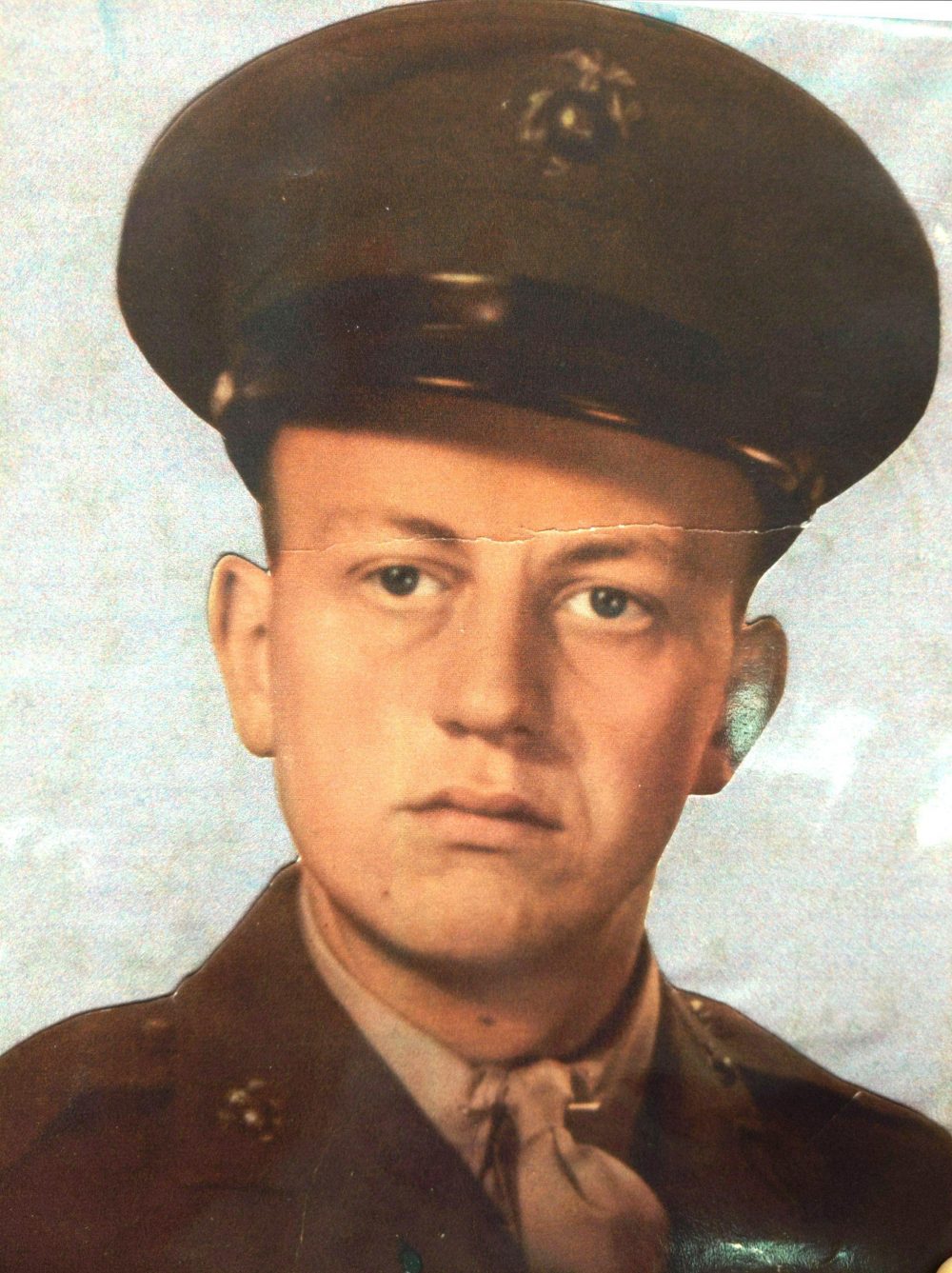
- Unit: Marine Fighter Squadron 122
- Service Number: 336372
- Date of Birth: May 4, 1920
- Entered the Military: January 5, 1942
- Date of Death: February 23, 1943
- Hometown: Chicago, Illinois
- Place of Death: Guadalcanal, Solomon Islands
- Award(s): Purple Heart
- Cemetery: Section A, Grave 615. National Memorial Cemetery of the Pacific, Honolulu, Hawai'i
Mentored by Mrs. Catherine “Katie” Clark
Gwendolyn Brooks College Preparatory Academy
2020-2021
Early Life
Elmer John Elsey was born on May 4, 1920, to parents Nora and Elmer Francis Elsey. They lived at 11222 Edbrooke Avenue in Chicago, Illinois.
His father served as an engineer in France during World War I. Elsey was the oldest surviving sibling and had three younger brothers: Raymond, Roland, and Allen.
The 1940 U.S. Census reveals that 19-year-old Elsey completed two years of high school. It is unclear where he attended school, as records are unavailable. His younger brother Allen graduated from Fenger High School in the 1950s.
Elsey worked at the Pullman Standard Car and Manufacturing Company as a construction draftsman. The Pullman Company employed many workers living in Roseland.



Homefront
Chicago was a vast and bustling city at the start of World War II. About 400,000 Chicagoans went off to war, and the average Chicago block had seven people enlisted in the service. Chicago had been a center of railroad transportation since its early inception. This rail transportation network moved thousands of U.S. soldiers through Chicago as they went off to train or return home. Many of these soldiers rode in the comfortable Pullman Palace cars manufactured in Chicago and where Elsey worked before his enlistment. The City Servicemen Centers, the Travelers Aid Society, and other civic groups providing USO travel lounges accommodated U.S. service members in Chicago.
Due to its location off of Lake Michigan, Chicago’s Navy Pier helped to train thousands of pilots to take off and land on the new aircraft carriers that dominated the Pacific Theatre. The nearby Great Lakes Naval Training Station trained nearly one-third of the nation’s naval recruits in World War II. Northwestern University’s naval midshipman program became the largest in the U.S. (future President John Kennedy completed his officer training there).
The U.S. Navy tried to simulate aircraft carriers’ conditions, so they bought paddle-like steamers, the USS Wolverine, and the USS Stable. The ships had their decks cleared, converted into makeshift aircraft carriers. The two ships sailed out in the daylight to receive pilots practicing their landings. Over 60,000 pilots, engineers, and mechanics trained for the Naval Air Corps in Chicago. Additionally, African Americans trained to be pilots came to Chicago’s Harlem Airport to learn the basics before heading south to join the world-renowned Tuskegee Airmen.
Over 1,400 Chicago factories supplied war goods. Companies received orders from the U.S. government to make goods for the war effort. Defense plants sprung up all over the Chicago metropolitan area as laborers manufactured aircraft engines at several automobile plants and other facilities. In 1943, Pullman Standard established a shipbuilding division and entered wartime small ship design and construction. In two years, the company built 34 Corvette PCEs, which were 180 feet long and weighed 640 tons, and 44 LSMs (Landing Ship-Medium), 203 feet long weighed 520 tons.
Pullman ranked 56th among United States corporations in the value of World War II military production contracts. For this factory production to keep pace with war demands, some 60,000 African Americans came from the American South to Chicago to work in the war factories and became an integral part of the war effort. Also, over 40,000 Chicago women entered factories and attended industry classes at local high schools. Almost all citizens in Chicago contributed to the war effort by purchasing war bonds, collecting aluminum and rubber and paper for the war effort, and saving cooking fats and grease. They also grew victory gardens as either communal large mass plots or in their backyards.
Chicago also earned recognition for its role in the Manhattan Project and the advent of nuclear weapons. Chicago is considered the atomic age’s birthplace, where John Simpson, a young scientist, developed plutonium. He worked on the project in secret with physicist Enrico Fermi and 40 other scientists. These scientists completed the first sustained nuclear chain reaction and atomic fission underground at the University of Chicago’s Stagg Field. On December 2, 1942, the first successful chain reaction occurred. According to the secret message, the scientist informed President Franklin Roosevelt, “The Italian Navigator has landed in the New World!” The scientific breakthrough led to the Manhattan Project and the end of World War II in the Pacific Theater.


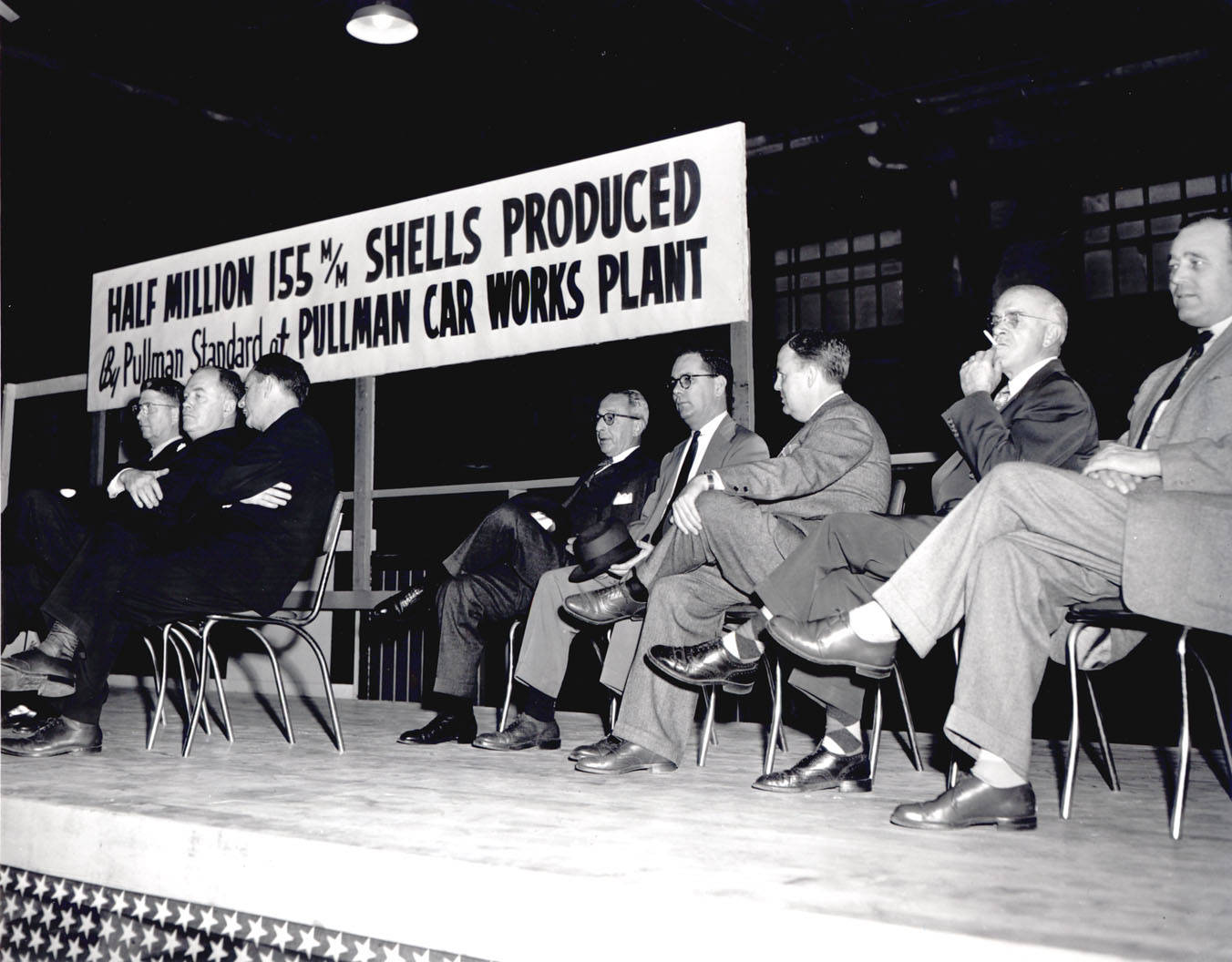
Military Experience
Elsey registered with the military on July 1, 1941, in compliance with the Selective Training and Service Act of 1940, also known as the Burke-Wadsworth Act.
Elsey joined the U.S. Marine Corps (serial number 336372) on January 5, 1942, in San Diego, California. After that time, he trained as an engineer with the Marine Fighter Attack Squadron 122. Their fighting squadron was officially commissioned on March 1, 1942, at Camp Kearny in San Diego, California. The squadron trained in San Diego until March 1942, when they moved to Chicago’s Navy Pier. While in Chicago, Elsey learned to maintain his squadron’s planes. The men typically flew the F4F-4 Wildcat or the F4U Corsair. He stayed at Chicago’s Navy Pier training facility until September 18, 1942.
Elsey and the members of the Marine Fighter Squadron 112 (VMFA-122, nicknamed “The Candystripers”) returned to San Diego to receive their orders.
The U.S. military assigned the code name Operation Pestilence to the entire offensive operation in the South Pacific. The effort to take Guadalcanal, known as Operation Watchtower, was essential to secure its airfield. U.S. Marines landed in Guadalcanal in August 1942.
In January 1943, Elsey and then men of Marine Fighter Squadron 112 arrived and were stationed at Henderson Field on Guadalcanal and Espiritu Santo, off Australia’s northeastern coast. The group launched offensive actions against enemy strongholds, airpower, and shipping in the Solomon Islands.
The airfield on Guadalcanal, re-named Henderson Field, became a critical lifeline for U.S. forces. The Japanese knew of Guadalcanal’s importance and tried everything in their arsenal to retake the island and destroy the airfield. According to Elsey’s letters home, he was in good health and very excited about his promotion to corporal on January 16, 1943.
The geography and terrain of Guadalcanal and Espiritu Santo posed many challenges to the men stationed there. On Espiritu Santo, Marines slept on mud floors next to a flooded coconut grove. The stagnant led to large numbers of mosquitoes. Then men faced constant threats of land and bombing raids. Being an engineer in charge of plane maintenance, Elsey continuously worked with the pilots. According to a letter from his commanding officer to Elsey’s mother, Elsey “…took great pride in his work and was always one of the first to see that his plane was ready for the next flight as early as possible after it’s return from the last mission.”
The pilots and aircrew proved vital to the campaign to taking control of Guadalcanal. They provided close air support for U.S. Marines on the front lines and scouted Japanese ships approaching the island. The devastating attacks delivered against them stemmed from reinforcements and supplies bound to the Japanese garrison on Guadalcanal. The Allied forces’ constant push and the sacrifices of so many finally led to an Allied victory at Guadalcanal on February 9, 1943. Even though this was the official end of this battle, sadly, the fighting and air raids did not stop.
In the early morning hours of February 23, 1943, the Japanese attacked the Marine installation at Guadalcanal. Like the other air raids, the men sprang out of their tents and into their nearby foxholes. According to the letter to his mother, “…six other men with Elmer took refuge in their prepared cover near their tent, after the bombing we found that all were safe except one.” Written in his Service Record book, the U.S. Marine Corps stated that Elmer died during this bombing raid when flying debris struck him in the back of the head and fractured his skull. Though medics attended to Elsey almost immediately, he never regained consciousness and died en route to the hospital.
He was buried with the other heroes of this fight at the temporary cemetery on Guadalcanal. His commanding officer told his mother that everyone missed him immensely because of his hard work ethic and his willingness to help anyone at any time.
His mother communicated with the U.S. Marine Corps on several occasions, asking them to make sure they had the right person because she received a final letter from Elmer, dated February 23, 1943 (the day he died). He had just recently earned a promotion to corporal, so maybe they were confused. Sadly, records confirmed that Elsey died on Guadalcanal.
In an interview with his younger brother, Allen, he revealed that his brother wrote that whenever he missed him to look at the American flag that flew over his school. That same flag flies over his tent, so when Allen would look at an American flag, he was also looking at his big brother.

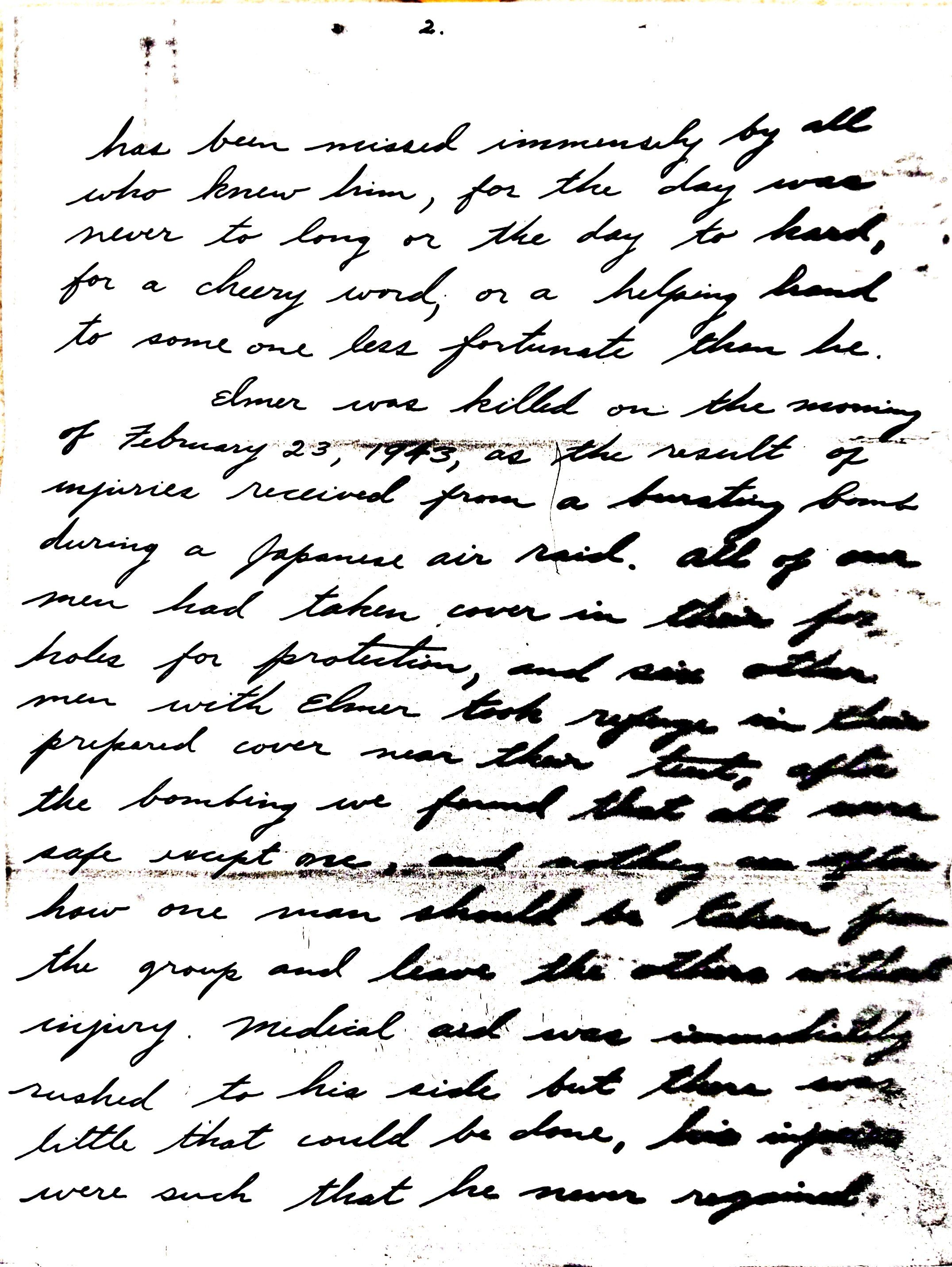
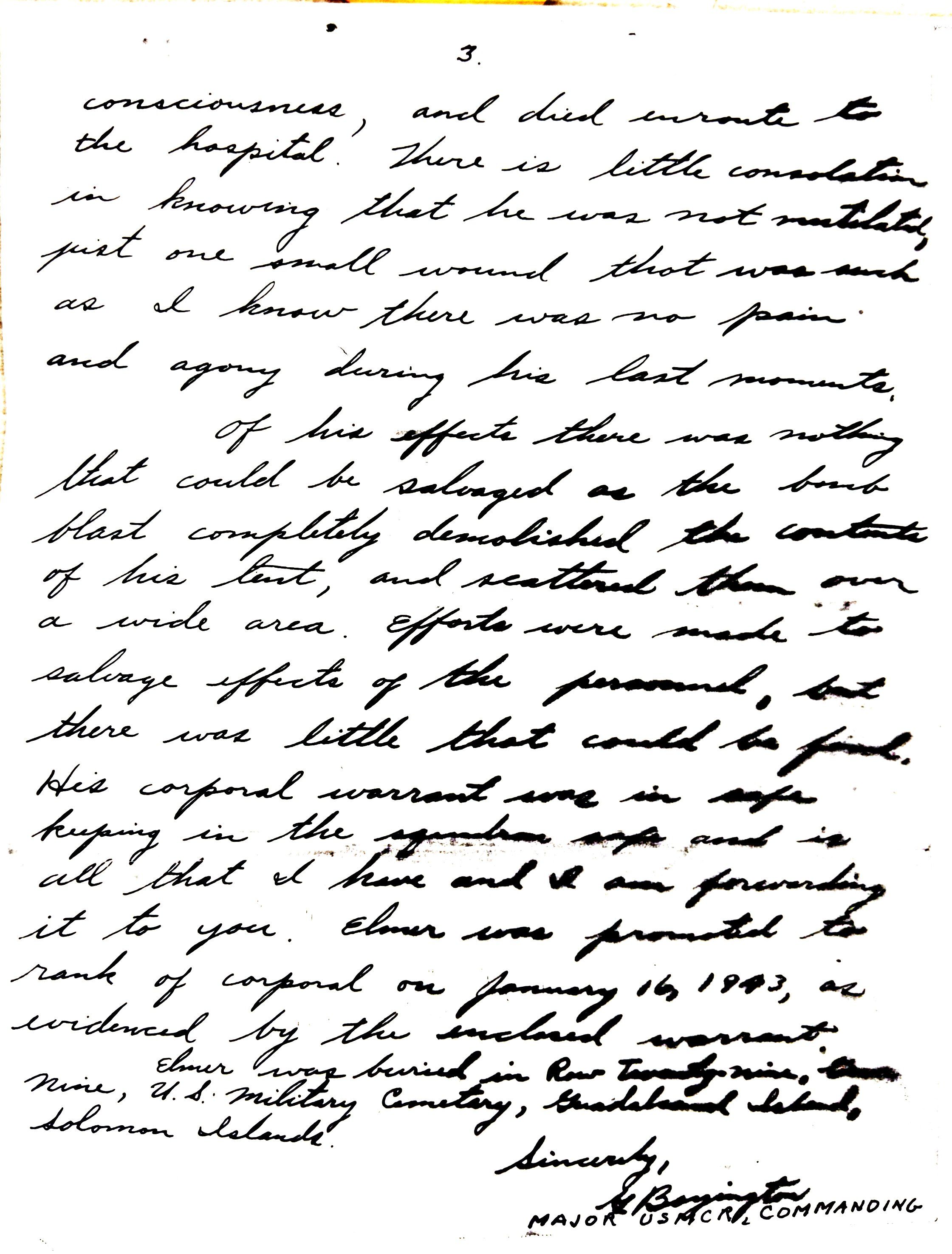
Eulogy
Corporal Elmer John Elsey was born May 4, 1920, in Chicago, Illinois, to parents Nola and Elmer Francis Elsey. Following in his World War I veteran father’s footsteps, Corporal Elsey registered with the military on July 1, 1941 and enlisted in the U.S. Marine Corps on January 5, 1942, in San Diego, California.
Corporal Elsey’s squadron was sent on their first combat tour in the Pacific Theatre in October 1942. They initially operated out of Espiritu Santo, a military supply and support base, naval harbor, an airfield located in an archipelago off Australia’s northeastern coast.
With the arrival of air support, the U.S. finally hoped during the trying Battle of Guadalcanal, which was part of the campaign known as Operation Watchtower. Despite the challenging conditions the Marines faced, Elsey wrote home that he was in good health and excited about his promotion to corporal.
In the early morning of February 23, 1943, the Japanese attacked the Marine installation at Guadalcanal. According to the letter sent to his mother, “… six other men with Elmer took refuge in their prepared cover near their tent, after the bombing we found that all were safe except one and no one understood how one man should be taken from the group, and left the others without injury.”
Corporal Emler John Elsey was buried at the island’s temporary cemetery. His death was tough on both his family and his aircraft group, as his commanding officer told his mother, saying that everyone missed his strong work ethic as well as his willingness to help anyone at any time.
The patriotism and sentiment of Corporal Elsey were well expressed in a letter written before he died in which he comforts his lonesome eight-year-old brother Allen Elsey. “Tell Allen to look at the flag that waves over his schoolhouse,” the letter said, “there is another like it that follows me wherever I go. When he misses me, tell him to look at that flag, and he will see me looking down at him.”
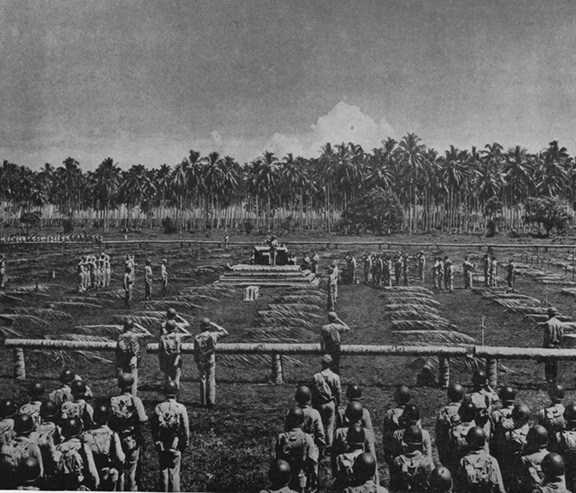


Reflection
My experiences in National History Day’s Sacrifice For Freedom®: World War II in the Pacific program breathed life back into my love for history, which was dampened by the pandemic and events of the summer of 2020. From the tours, activities, and narratives shared, I’ve gained a better understanding of the December 7 attacks on Oahu bases and new long-lasting friends.
During the two-year process of Silent Hero research and eulogy writing, I came to appreciate the importance of survivor and fallen hero accounts that provide better insight on the scope of World War II and its effects on families and civilian life as a whole. While emotional, reading the eulogy for my Silent Hero, Corporal Elmer John Elsey, was a transformative experience that will live with me forever. Delivering the eulogy at the National Memorial Cemetery of the Pacific, Corporal Elsey’s final resting place, felt surreal, as though he was in the crowd cheering me on. Reflecting on it now, you develop a special connection with your Silent Hero that compels you to share their story with everyone you meet, hoping they rest reassured and at peace, knowing their stories and sacrifices will never be forgotten.
In the end, my biggest takeaway from the trip is that there’s so much more we need to learn about the people who lived through and served in World War II. Without their effort and sacrifices, we wouldn’t be where we are today, good and bad alike.
Bibliography
Primary Sources
Elmer Elsey in Uniform. Photograph. 1941-1942. Courtesy of Allen Elsey.
Elmer John Elsey. Casualty Card. U.S. Marine Corps History Division, Quantico, VA.
Elmer John Elsey. Certificate of Birth, State of Illinois Department of Public Health. May 12, 1920. Digital Images. ancestry.com.
Elmer John Elsey. National Cemetery Interment Control Forms, 1928-1962. Digital Images. ancestry.com.
Elmer J Elsey. National Memorial Cemetery of the Pacific (Punchbowl), 1941-2011. Photograph. Digital Images. ancestry.com.
Elmer John Elsey, Official Military Personnel File, Department of the Navy. U.S. Marine Corps, Record of the U.S. Marine Corps, RG 127, National Archives and Records Administration – St. Louis.
Elmer John Elsey. Rank Advancement Certificate. January 16, 1943. Courtesy of Allen Elsey.
Elmer J. Elsey. U.S. Navy Casualties Books, 1776-1941. Digital Images. ancestry.com
Elmer John Elsey. WWII Draft Cards Young Men, 1940-1947. Digital Images. ancestry.com.
Elmer J. Elsey. World War II Navy, Marine Corps, and Coast Guard Casualties, 1941-1945. Digital Images. ancestry.com.
Half Million 155MM Shells produced by Pullman Standard of Pullman Car Works Plant. Photograph. c. 1942-1945. Illinois Digital Archives, Pullman State Historic Site (8366: PF04.01.14ABCDEFGH). Illinois Digital Archives, Illinois State Library, Office of the Secretary of State and State Librarian. www.idaillinois.org/digital/collection/pshs/id/19709.
Illinois. Cook County. 1930 U.S. Census. Digital Images. ancestry.com.
Illinois. Cook County. 1940 U.S. Census. Digital Images. ancestry.com.
“In Memoriam: Chicagoans Who Have Died in World War II.” Chicago Daily Tribune, May 30, 1943. ProQuest Historical Newspapers.
Launching of Naval Patrol Escort Vessel PCE-828 Program Booklet. May 15, 1943. Courtesy of Allen Elsey.
Major George Boyington to Mrs. Nora Elsey. April 23, 1943. Courtesy of Allen Elsey.
Major H. G. Gunter to Mr. and Mrs. Elmer F. Elsey. U.S. Marine Corps Killed in Action Certification. August 25, 1948. Courtesy of Allen Elsey.
Marine Cemetery, Guadalcanal, Solomon Islands. Photograph. Digital Images. ancestry.com.
Pullman Civil Defense Rally. Photograph. c. 1942-1945. Illinois Digital Archives, Pullman State Historic Site (13945: PF2011.12.08). Illinois Digital Archives, Illinois State Library, Office of the Secretary of State and State Librarian. www.idaillinois.org/digital/collection/pshs/id/16571.
“Second Pullman Ship Launched; Hail Slain Hero.” Chicago Daily Tribune, May 16, 1943. ProQuest Historical Newspapers.
Secondary Sources
Baldwin, Hanson W. Battles Lost and Won: Great Champions of World War II. New York: Smithmark Publisher Inc., 1966.
Beck, Roger. Modern World History: Patterns of Interaction. Evanston: McDougal Littell, 1999.
Elton, Wallace W. Navy in the Sky. New York: Whittlesey House, 1944.
Gilbert, Martin. The Second World War: A Complete History. New York: Henry Holt & Company, 1989.
Green, Paul Michael and Melvin G. Holli. World War II Chicago. Charleston: Arcadia, 2003.
Helge, Janice. “The Calumet Index: Greater Pullman’s War Years.” The Pullman History Site. Updated December 1, 2019. Accessed March 1, 2020. www.pullman-museum.org/thePeople/pwy.html.
“Navy Pier, 1914-1946.” University of Illinois Chicago Archives. Updated 2016. Accessed December 4, 2020. uicarchives.library.uic.edu/history-of-uic/navy-pier-1914-1946/.
Spinney, Robert Guy. City of Big Shoulders: A History of Chicago. DeKalb, Ill: Northern Illinois Univ. Press, 2000.
Vandergrift, General Alexander A. Battle Stations: Your Navy in Action. New York: Wm.H.Wise & Co., Inc; 1946.
“World War II Images.” The Pullman History Site. Modified April 2020. Accessed June 5, 2020. www.pullman-museum.org/pshs/pshsBySubject.php?subject=World_War_II.

